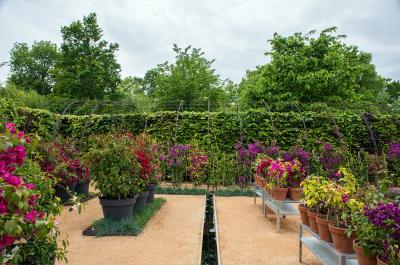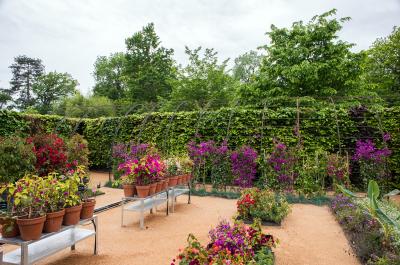16. LE JARDIN DES BOUGAINVILLIERS
Green card given to the Conservatory of Specialist Plant Collections
published at 19/09/2017
With plant collections taking pride of place this year, it seemed to make perfect sense to partner up with the National Plant Collections.

Initiated under the auspices of Frédéric Pautz, Head of the Lyon Botanical Garden and Vice-President of CCVS, this special partnership is taking shape through the National Collection of Bougainvillea.
Acclaimed breeders and nursery gardeners have got involved in the "Collectors' gardens" theme of the International Garden Festival by shining the spotlight on the quality and mind-boggling diversity of their collections. The National Collection of Bougainvillea will be representing the CCVS with the Ets Horticoles du Cannebeth, which will be showcasing their extraordinary lantana collection among other things.
In addition to botanical plants (i.e. those found wild in nature), brought back from far-flung corners of the planet by intrepid explorers, gardeners have also used a variety of methods (hybridisation, cloning, mass selection, GMOs, etc.) to breed a vast range of horticultural cultivars and varieties which, worldwide, number in their tens of thousands.
In this way, some 45,000 species and cultivars now make up the botanical and horticultural heritage in France - bringing the whole of this longstanding history to bloom as it were. At the Chaumont-sur-Loire gardens, as elsewhere, a Chinese perennial might find shelter under the boughs of an American tree, and a horticultural rose from the 19th century might round off the range of colours showcased by a flowering hortensia recently selected by a research laboratory.
There are many public and private institutions in France working to protect this heritage: botanical gardens, nursery gardeners of collections, research institutes, associations and networks of specialists... A national network of collections and collectors was created 25 years ago: the Conservatory of Specialist Plant Collections (CCVS). Among this network's collections are the citrus fruit of the town of Menton, camellias from the Finistère département, tropical orchids from the Jardin du Luxembourg (in Paris) and the tropical begonias from the City of Lyon.
It is therefore an excellent initiative on the part of the organisers of the Chaumont-sur-Loire International Garden Festival to pay tribute to French living plant heritage - the fruit of a long and magnificent history filled with encounters and discoveries between humankind and our environment." Frédéric Pautz, Head of the Lyon Botanical Garden and Vice-President of CCVS.
designer
THE CONSERVATORY OF SPECIALIST PLANT COLLECTIONS
FRANCE
Many species and varieties disappear forever from our horticultural and botanical heritage every year. Founded in 1989 by scientists and plant enthusiasts, the Conservatory of Specialist Plant Collections (C.C.V.S) sets out to bring together everyone who would like to help prevent the disappearance of this wealth and this biodiversity. The Conservatory of Specialist Plant Collections has drawn up a Collections Charter and works alongside public and private holders of plant collections.
Its primary task is to list the main botanical and horticultural collections before assessing them with a view to attributing one of two recognitions:
- "CCVS National Collection" for a collection of national interest that meets criteria of excellence; or
- "CCVS Accredited Collection" for a collection that still needs completing or presents shortcomings as regards the way it is tended, managed or sustained, such that the "CCVS National Collection" cannot be awarded yet.
Furthermore, the Conservatory of Specialist Plant Collections has undertaken major digitisation of the collections making up its networks.
By compiling this database of over 45,000 botanical and horticultural taxa, which has been possible thanks to all of the plants making up the various CCVS-recognised collections, we are able not only keep a very detailed inventory of this inestimable genetic resource but also to identify where these plants come from, understand their background and register them in line with the botanical nomenclature in force.
Respecting nature
The Conservatory of Specialist Plant Collections recognises the need:
- to protect nature through in situ conservation.
- for mutual, fair interests in action undertaken.
- to comply with national and international regulations.
The Conservatory of Specialist Plant Collections makes no exception in its outright disapproval of picking wild plants in nature.
Relevant collections
The Conservatory of Specialist Plant Collections defends the relevance of the plant collections ex situ, in which its very purpose lies.
It holds to the following premises:
- the collections are the source of the basics of knowledge about the plant world (herbariums, botanical gardens, collections, etc.).
- the collections are the source of the wealth of flora in gardens and across the countryside in Europe in particular.
- the collections can be conservatories for safeguarding some endangered species.
- the collections give collectors the chance to find the plants they are after, thereby reducing the impact of these very plants being picked from their natural environment.
The CCVS' objectives
The Conservatory of Specialist Plant Collections is also keen on developing other measures:
- education and information (charter, code of good conduct, articles, conferences).
- raising the awareness of collectors and the public about the destruction of biotopes and protection of biodiversity.
- organising information sessions and botanical outings to see the real extent of these problems in the field.
- official, monitored multiplication of endangered plants for their dissemination among our collections.


